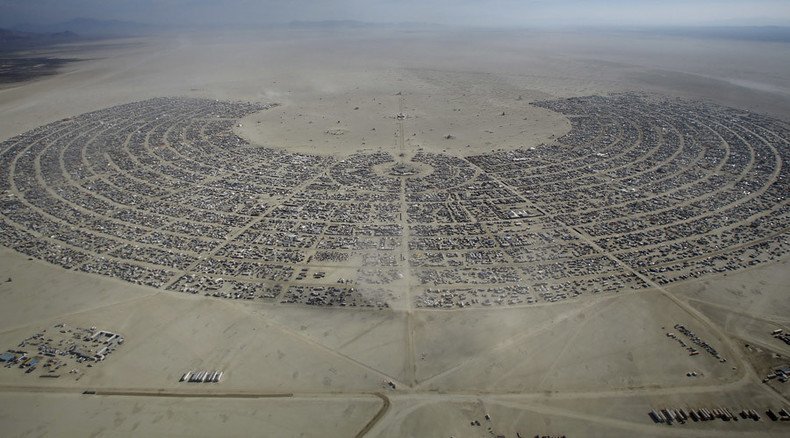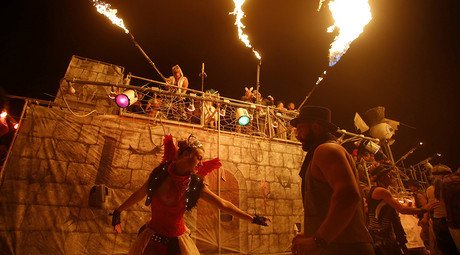FBI admits to spying on Burning Man

Federal agents spied on Burning Man festival in the Nevada desert in 2010, citing the need to collect intelligence and prevent terrorism, newly released documents reveal. However, they found no threats apart from festival-goers using 'illegal drugs.'
Internal documents from the Federal Bureau of Investigation were provided to investigative journalist Inkoo Kang in February 2013, but were just made public as the 29th annual festival got under way. Some 70,000 people were expected in attendance at Black Rock City, a temporary camp in the remote desert of Nevada.
An August 19, 2010 memo from the FBI to all field offices says the Bureau would work with the local authorities to “aid in the prevention of terrorist activities and intelligence collection.” Another memo, a week later, says the Bureau was contacted by a security company hired by Burning Man to do a threat assessment. The FBI said it had “no intelligence indicating any outside threats, domestic or international,” to the event. To the Bureau’s knowledge, the greatest threats during the festival were “crowd control issues and use of illegal drugs by participants.”
The FBI infiltrates Burning Man festival, collects intelligence, documents show http://t.co/1ZDskADfBfpic.twitter.com/xZDviHY7b4
— SaraLeighMcWilliams (@saraland555) September 3, 2015Even so, the Bureau’s Las Vegas office sent an unspecified number of agents to attend Burning Man, citing the “ongoing war on terrorism and potential for additional acts of terrorism” in the US. The agents filed a report on September 27, noting that the festival passed “with no adverse threats or actions.”
The Bureau of Land Management (BLM) issued almost 300 citations and arrested 8 people at the 2010 event, attended by more than 50,000 ‘Burners’.
While at first blush this may look like Las Vegas FBI looking to have a bit of fun at Burning Man at government expense, legal and media analyst Lionel was disturbed by the revelations, seeing shades of J. Edgar Hoover’s notorious COINTELPRO in the Bureau’s presence in the desert.
“I don’t understand why Americans don’t understand you have the right to be left alone,” Lionel told RT. “You have the right to not be surveilled… just because some agent somewhere says ‘You know, we might be able to learn something'.”
RT News BriefRT News Brief: The Feds are attending #BurningMan.
Posted by RT America on Wednesday, September 2, 2015
Between the 1950s and 1971, the FBI infiltrated groups and organizations across the US with the stated goal of “protecting national security, preventing violence, and maintaining the existing social and political order.” COINTELPRO tactics included psychological warfare, false media reports, harassment, imprisonment and character assassination. The program was supposedly discontinued after the Church Committee hearings in the late 1970s.
It took six months for the FBI to respond to Kang’s freedom of information request, submitted in August 2012. Documents released by the Bureau were redacted to hide the identity of the agents involved, and any actual techniques or tactics they might have used to gather intelligence among the ‘Burners’. Questions remain whether the FBI limited its surveillance of Burning Man to just the 2010 festival, or continued the operation in subsequent years. The Bureau did not comment on the release of the documents.
Burning Man festival permit battle ends as feds back off $1mn facility requirement http://t.co/TfB2rqg7gapic.twitter.com/KaZhVmSNIF
— RT America (@RT_America) August 11, 2015This year’s Burning Man ran into some trouble with the regulators last month, when the Bureau of Land Management (BLM) requested special VIP accommodations for its employees and other federal officials. The $1 million 'Blue Pit Compound' was to be outfitted with hot water, air conditioning, refrigerators, laundry machines, and flushing toilets. The feds went so far as to demand constant access to Choco Tacos, a particular brand of ice cream, according to the Reno-Gazette Journal.
Under the long-standing rules of Burning Man, crafted to comply with federal environmental impact rules, everything that is brought to the week-long gathering is dismantled or destroyed, leaving no trace of human presence in the desert after the festival ends. The BLM eventually abandoned its “outlandish” request, allowing the 2015 festival to proceed.
The first Burning Man took place in 1986, when 35 people gathered for the burning of an 8-foot wooden effigy at a beach in San Francisco, California. In 1990, the event moved to Black Rock Desert in Nevada, and in 1994 started charging admission ($30 at the time). By 2014, almost 66,000 people attended the festival, paying $380 per ticket. The temporary 'city' in the desert is about 12 miles from the nearest permanent settlement of Gerlach, Nevada and 75 miles from Reno.













